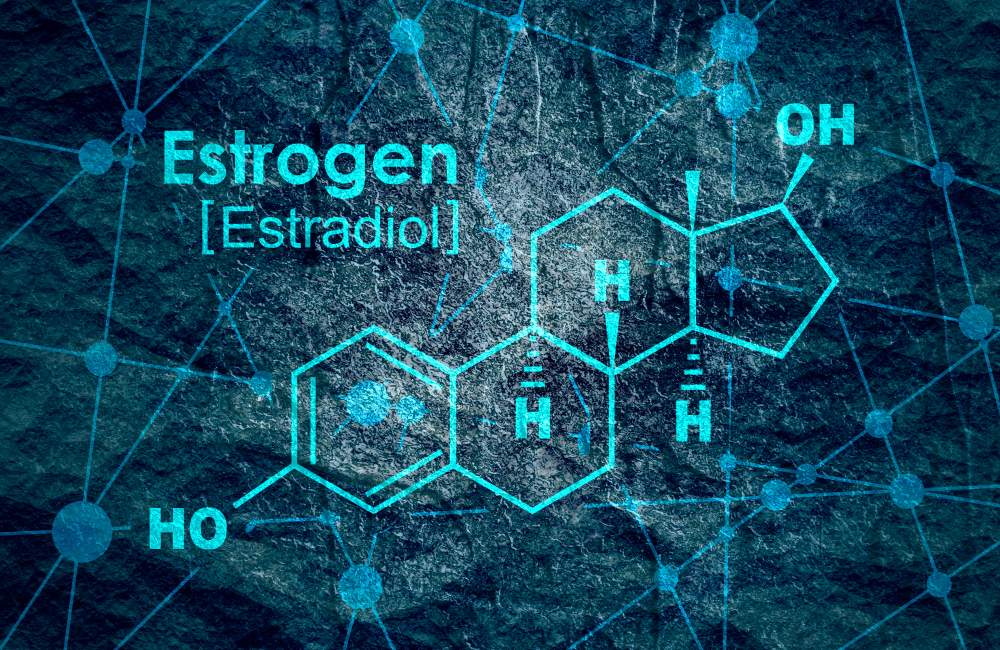Estrogen synthesis in the brain and neural function
Posted on 22nd February 2023 by Davide E. De Dominicis

Introduction
The endocrine system represents a complex and fascinating dimension with a strong relationship of various organs. Chemical mediators physiologically contribute to a heterogeneous group of events, the number of which is still rising. The review summarized in this blog aims to provide an extensive overview of the roles played by 17β-estradiol (E2). This hormone is a brain-derived estrogen, produced by the enzyme aromatase and involved in maintaining and promoting neural function.
While looking in detail at these functions, this summary will highlight problems and questions that remain open. This blog will also present potential avenues to investigate this sphere of neuroendocrinology in the future.
Producing estrogen: localization of aromatase in the brain
Recent evidence has shown an elevated enzyme synthesis in various regions of the brain such as the thalamus, amygdala or hippocampus. Positron Emission Tomography (PET) studies confirm the existence of sex differences in enzyme concentrations in the left hypothalamus. Other studies have found a significant aromatase expression especially in synaptic boutons and cell bodies of various neuronal cytotypes.
Interesting investigations could explain sex differences in aromatase localization. Studies showed that XY mouse presented higher aromatase expression in the amygdala than XX embryos, independent of gonadal sex. There is, nowadays, little evidence of similar processes in other brain regions and other species. Other results from studies analyzing these differences appear to be contradictory due to differences in the study design. For example, some studies obtained significant results by choosing an in vitro approach that are in contrast with evidence obtained in vivo. To find out more about the differences between these approaches here is provided an interesting overview: In Vivo vs. In Vitro: What Does It All Mean?
To regulate E2 production in the brain, there is considerable evidence of the involvement of transcriptional and post-transcriptional mechanisms. Calcium-dependent or glutamate-dependent phosphorylation, for example, consent to rapidly modulate estrogen production depending on the sites of aromatase phosphorylation. Methylation can instead inhibit E2 synthesis at a transcriptional level in glioblastoma cells. Currently, however, there is limited evidence of an analogue effect on normal cells of the Central Nervous System (CNS).
Regulation of estrogen synthesis: key molecular processes
Hormones play an important role in regulation of E2 synthesis. Testosterone appears to increase aromatase activity by increasing the enzyme’s mRNA levels in the brain of several animal models. E2 itself proved to be effective in regulating aromatase activity but often with divergent results due to differences in study design.
Evidence demonstrates similar roles for progestins, glucocorticoids and peptide hormones like GnRH and GnIH in aromatase regulation. It is interesting to highlight that the glucocorticoid, dexamethasone, is the strongest regulator found for the brain-specific 1.f exon promoter in the E2 gene.
Some studies have also investigated the role played by other factors like aging or pollutants in disturbing E2 production. Aging seems to contribute to the decrease of the E2 levels by decreasing aromatase expression and other enzymes necessary to steroidogenesis. Other research has shown that pollutants like bisphenol A, inducing oxidative stress and inflammation, could led to an increase of E2 production, probably as a brain’s defence mechanism, but further evidence is needed.
Finally, some studies focused on the aromatase induction after brain injury and inflammation. As of today, the mechanisms underlying these events are still not clear.
Effects of E2 in neural function: synaptic plasticity, cognitive aspects and neuroprotection
Synaptic plasticity is an activity-dependent change in neuronal connection strength fundamental in learning and memory (Magee et al., 2020). In various species, experiments conducted with letrozole, an aromatase inhibitor, showed that a decrease in E2 levels reduced synaptic density both in vitro and in vivo but often with contrasting results while considering sex differences between subjects. The authors suggest that higher doses of inhibitor may be required to observe significant effects in male subjects. To conduct a well-performed study while considering variables like sex it is important to know how to choose subjects from a population with the appropriate sampling method. Read more about this topic here: What are sampling methods and how do you choose the best one?
Studies based on the use of letrozole were also performed to assess the potential of E2 in modulating memory and cognitive functions in humans and animal models. For example, cognitive testing and MRI analysis were used in a study conducted in women treated with letrozole. This study revealed that the pharmacological treatment impaired hippocampal processes linked to memory. In murine models, similar protocols involving letrozole showed a significant decrease in E2 levels in association with defects in working memory and novel object recognition abilities.
Over the past two decades, several investigations demonstrated a neuroprotective role for estrogen. Initial studies focused in particular on the increase in E2 levels after aromatase induction in astrocytes following brain injury. Moreover, these studies showed that testosterone and E2 were neuroprotective against the effects of domoic acid, a neurotoxin. Administering an aromatase inhibitor resulted in the block of the role of testosterone in these processes, suggesting that only its conversion in E2 can guarantee the appearance of the neuroprotective effects. Further work has demonstrated the existence of neuroprotection E2-mediated in other brain regions. Few studies, however, used female animal subjects, but they demonstrated the same role for estrogen as previously seen.
Author conclusions and personal considerations
In this blog, I have highlighted the main hypothesis to explain contrasting results of the studies analyzed by the review. Study design differences were often an important reason to explain these contrasts.
Further studies could give an appropriate answer to questions that remain unsolved. The authors suggest that the development of new animal models could help researchers by reducing the number of variables involved. Sex differences in estrogen production and activity remain to be clarified and better explained. For this reason, the authors suggest focusing on direct comparisons between animal subjects from both sexes. Physicians need to perform adjunctive clinical research: studies involving human brain post-mortem samples could represent an interesting future direction.
The review summarized here covers mainly basic science studies and provides little clinical evidence. In my opinion, however, the paper could be useful to understand bio-molecular mechanisms in this prolific topic for future research. Thanks to more clinical research, scientists could finally help design new therapeutic approaches to the symptomatic presentation of neurologic patients such as those living with dementia, or in neuropsychiatric diseases like depression or schizophrenia (Russell et al., 2019).
References
THE REVIEW: Brann, D. W., Lu, Y., Wang, J., Zhang, Q., Thakkar, R., Sareddy, G. R., Pratap, U. P., Tekmal, R. R., & Vadlamudi, R. K. (2022). Brain-derived estrogen and neural function. Neuroscience and biobehavioral reviews, 132, 793–817. https://doi.org/10.1016/j.neubiorev.2021.11.014
OTHER REFERENCES
Magee, J. C., & Grienberger, C. (2020). Synaptic Plasticity Forms and Functions. Annual review of neuroscience, 43, 95–117. https://doi.org/10.1146/annurev-neuro-090919-022842
Russell, J. K., Jones, C. K., & Newhouse, P. A. (2019). The Role of Estrogen in Brain and Cognitive Aging. Neurotherapeutics : the journal of the American Society for Experimental NeuroTherapeutics, 16(3), 649–665. https://doi.org/10.1007/s13311-019-00766-9



